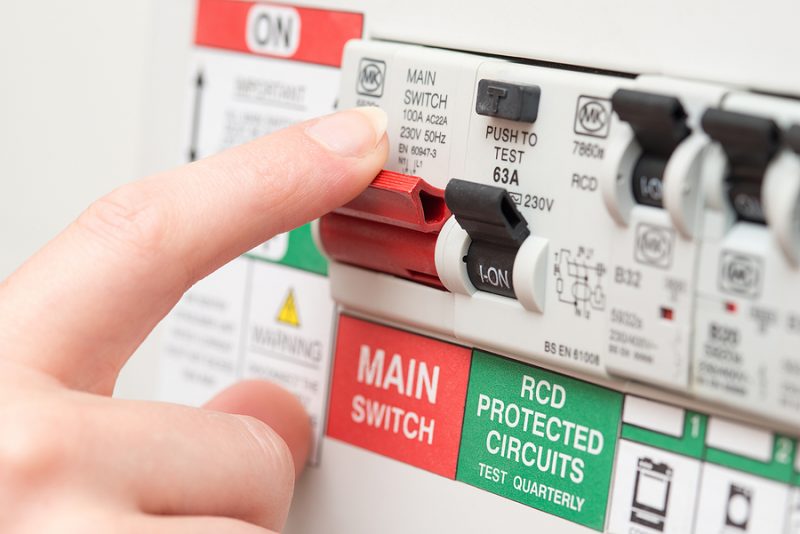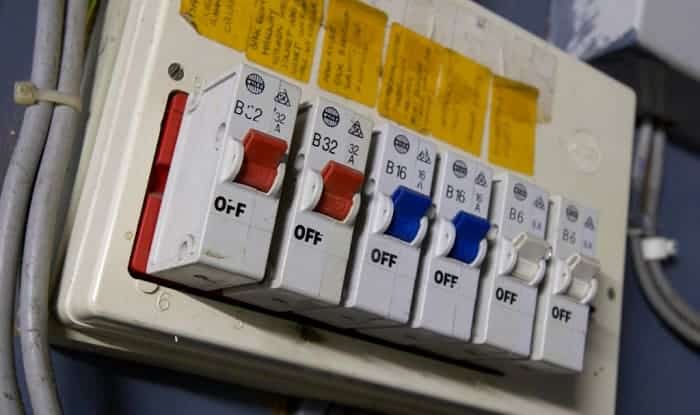If your electricity keeps tripping at night, it could be due to a couple of reasons. One common cause is having too many appliances running at the same time, which overloads the circuit. Especially in the evening when people use more devices simultaneously, the circuit might trip to prevent damage.
Another possible reason is faulty wiring, outlets, or appliances. Check for any visible damage or signs of wear. If the problem persists, it’s best to consult with an electrician to identify and fix the issue for a safer and more reliable electrical system.
Common Causes of Electrical Tripping

Electrical tripping refers to the situation where a circuit breaker or fuse interrupts the flow of electric current due to an overload or fault in the electrical system. There are several common causes of electrical tripping:
Overload: This is one of the most common reasons for tripping. It occurs when the current flowing through a circuit exceeds its designed capacity. This can happen when too many devices are connected to a single one drawing more current than it can handle.
Short Circuit: A short circuit occurs when a hot wire comes into direct contact with a neutral or ground wire. This creates a low-resistance path, allowing a large amount of current to flow, leading to rapid overheating and tripping of the breaker.
Ground Fault: Similar to a short circuit, a ground fault occurs when a hot wire comes into contact with a ground wire or a grounded part of a device. This can lead to excessive current flow.
Faulty Appliances or Devices: It may be caused by a malfunction in an appliance or device connected to it This could be due to a short circuit within the device or a problem with its electrical components.
Loose Wiring: Loose connections or damaged wiring can cause increased resistance in it. Loose wiring can be a fire hazard and should be addressed promptly.
Old or Faulty Circuit Breakers: Over time, they can wear out or become faulty. They may not trip as intended or trip too easily. Regular inspection and maintenance of them are essential to ensure their proper functioning.
Voltage Fluctuations: Sudden changes in voltage, such as power surges or fluctuations, can be a reason. Voltage spikes can be caused by lightning, power outages, or issues with the electrical grid.
Moisture or Water Damage: Water and moisture can compromise the insulation of electrical components. This is particularly relevant in outdoor or damp environments.
Environmental Factors
| Environmental Factor | Explanation | Impact | Solutions |
| Temperature Fluctuations | Extreme temperatures affect electrical conductivity, leading to malfunctions. | Expansion/contraction, increased resistance. | Insulate wiring, use temperature-resistant materials, and ensure proper ventilation. |
| Humidity and Moisture | Moisture compromises insulation, causing short circuits and corrosion. | Ground faults, corrosion, decreased insulation. | Seal outdoor components, use moisture-resistant materials, and install GFCIs in damp areas. |
| Corrosion | Exposure to corrosive elements corrodes connections and components. | Reduced conductivity, increased resistance. | Use corrosion-resistant materials, apply protective coatings, and inspect also clean components regularly. |
| Air Quality | Poor air quality leads to dust accumulation, affecting performance. | Reduced heat dissipation, the potential for arcing. | Regularly clean and maintain equipment, use air filters, and install dust-resistant enclosures. |
| Altitude | Changes in altitude impact dielectric strength and overall system performance. | Reduced insulation effectiveness, potential for arcing. | Choose altitude-appropriate insulating materials, design systems with altitude considerations. |
| Sunlight Exposure | Prolonged exposure to sunlight causes thermal stress on components. | Overheating, material expansion/contraction. | Install shading or protective covers for outdoor equipment, use UV-resistant materials. |
| Seismic Activity | Earthquakes and vibrations can cause physical damage and loosen connections. | Disruption of wiring, potential for short circuits. | Secure electrical components, use flexible conduit systems to withstand seismic activity. |
Troubleshooting and Solutions
Troubleshooting electrical tripping issues involves systematic investigation to identify and address the underlying causes. Here are some steps you can take to troubleshoot and potential solutions:
Identify the Circuit: Determine which circuit is tripping. This will help you narrow down the potential causes. Check the circuit breaker or fuse box to identify the affected one.
Reduce Load: If the tripping is due to an overload, reduce the electrical load on the circuit. Unplug or turn off some devices connected to it. Consider redistributing the devices across multiple circuits or use a higher-capacity one if needed.
Check for Short Circuits or Ground Faults:
- Inspect appliances and devices for damaged cords or plugs.
- Look for signs of burnt or damaged outlets.
- Use a multimeter to check for continuity between the hot and ground wires.
Inspect Wiring:
- Examine the wiring for signs of damage, such as fraying or exposed wires.
- Tighten any loose connections.
- Check for proper wire sizing; ensure the wire gauge matches the its amperage.
Test Appliances and Devices:
- Unplug all devices on the circuit causing the tripping.
- Gradually reconnect each device and monitor for any signs of tripping.
- If a specific device causes the tripping, it may be faulty and should be repaired or replaced.
Check for Moisture or Water Damage:
- Inspect areas for signs of water leakage or moisture.
- Ensure that outdoor outlets and electrical components are properly sealed.
Inspect Electrical Panel:
- Check the main electrical panel for any signs of damage or overheating.
- Tighten any loose connections within the panel.
- Consider consulting with a professional electrician to inspect and maintain the panel.
Test Circuit Breakers:
- Test the circuit breaker’s functionality by manually turning it off and then back on.
- If the breaker feels excessively hot, it may be faulty and should be replaced.
Consider Voltage Fluctuations:
- Install surge protectors to safeguard sensitive electronics from voltage spikes.
- If voltage fluctuations are a recurring issue, consult with an electrician to assess and address the problem.
Professional Inspection:
If you are unable to identify the cause of the tripping or if there are concerns about the electrical system’s safety, it’s advisable to consult with a licensed electrician.
Electricians have the expertise and equipment to perform thorough inspections and address complex electrical issues.
Simple Tips for Electrical Safety at Home

- Electric Shock:
- Don’t touch anything electrical when it’s on.
- If you need to fix something, turn off the power first.
- Use tools that won’t give you a shock.
- Fire Dangers:
- Check your wires and stuff for any problems.
- If you see a problem, fix it right away.
- Don’t plug too many things into one plug.
- Short Circuits:
- Make sure wires don’t touch where they’re not supposed to.
- Put things in the right places and check them sometimes.
- Overloaded Plugs:
- Don’t put too many things in one plug.
- Share the plugs with your stuff.
- Wrong Wiring:
- Get someone who knows what they’re doing to help with wiring.
- Don’t try it if you don’t know how.
- DIY Electrical Work:
- Don’t do electrical work if you don’t know how.
- Get someone who knows what they’re doing.
- No Ground Fault Protection:
- Use special plugs in wet places to be safe.
- These plugs can stop you from getting a shock.
- Exposed Wires:
- Keep wires covered so you don’t get shocked.
- Fix any broken wires you find.
- Electrical Panel Problems:
- Check your electrical box for any issues.
- If you see a problem, ask for help.
- Broken Appliances:
- If your stuff is broken, fix it or get a new one.
- Don’t use broken things with wires.
- Children’s Safety:
- Cover up plugs so little kids can’t touch them.
- Teach kids not to play with electrical stuff.
- Not Enough Air:
- Make sure things that use electricity don’t get too hot.
- Check if they have enough air around them.
- Ignoring Signs:
- If your lights are acting weird or you smell something funny, check it out.
- Don’t ignore things that seem wrong.
- Not Checking Recalls:
- Look out for notices about broken things.
- If your stuff is broken, get it fixed or throw it away.
- No Emergency Plan:
- Know where to turn off your power in case of an emergency.
- Keep a number for an electrician in case something goes wrong.
FAQ’s
Why does my electricity keep tripping in the middle of the night?
Common reasons your breaker keeps tripping include circuit overload, a short circuit, or a ground fault.
How do you find out what is tripping your electric?
Locate the small panel near your electrical service entrance. The “tripped” switch in this panel is likely causing the issue.
How do you fix electricity tripping?
Follow these three steps: Turn off affected lights and appliances, find the tripped breaker in the circuit box, and flip it from OFF to ON.
Why does my circuit keep tripping in my bedroom?
If there’s a circuit overload, avoid using everything at once. Experiment by unplugging or moving appliances to determine the load limit.
Should I be worried if my breaker keeps tripping?
Yes, don’t ignore it. Regular tripping indicates circuit overloading, risking an electrical fire. Seek professional help to address the issue.
Why is my meter tripping?
Circuit overloading, often from running too many power-consuming devices simultaneously, is the most common reason for meter tripping.
Is it safe to reset a tripped breaker?
Yes, It’s safe if the cause is determined to be circuit overload. However, if it’s due to a short circuit or ground fault, consult a qualified electrician.
Final Words
Persistent electrical tripping at night may stem from a combination of factors. Overloading the circuit due to increased evening electricity usage and the presence of faulty wiring or appliances are common culprits.
Moreover, regular checks for damaged components and consideration of household energy consumption habits can help pinpoint and address the root causes. Seeking professional assistance, especially from an electrician, ensures a thorough examination of the electrical system and promotes a safer and more reliable nighttime power supply.
